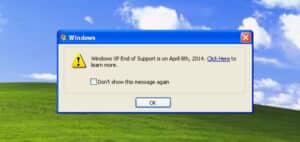From Windows XP to Windows 10 -- How Microsoft's end-of-life nag screens have changed

Microsoft has evolved its approach to warning users about the end of life (EOL) of its Windows operating systems over the years. The methods and techniques used, from Windows XP onwards, have varied, ranging from the polite to the downright aggressive (we're looking at you, Windows 7).
This journey, revealed in a new video, highlights how Microsoft's strategy has shifted to ensure users are aware of when their operating system will no longer receive support, emphasizing the importance of security and system updates and, in some cases, upgrading you against your will without warning (we're still looking at you, Windows 7).
Before Windows XP reached its end of life on April 8, 2014, Microsoft alerted users to this event with a simple pop up that could be dismissed by clicking on OK.

There was even a box you could tick so you wouldn't be shown the message again. It was both informative and unobtrusive.
Windows Vista did not have an end-of-life notification system, reflecting a different era in Microsoft's user communication and support strategy. The lack of such notifications in Vista likely contributed to the extended periods during which users remained on the now-unsupported operating system, potentially exposing them to security risks.
Microsoft turns evil
Windows 7, which reached its EOL on January 14, 2020, had a lot of nag screens. The notifications, which started appearing months before the EOL date, became progressively persistent. The Get Windows 10 (GWX) app, which was installed automatically, was a simple tool designed to help Windows 7 users upgrade to Windows 10. Until it transitioned into a form of malware, tricking users into upgrading to the new OS, even if they didn’t want to, downloading massive installation files in the background "just in case" the owner wanted to upgrade, and then, in some instances, starting the upgrade for them.
Microsoft played around with the language in the upgrade box to make it harder to understand exactly how to say no to the new OS, and then it changed the behavior of the red corner X so closing the popup didn't mean "go away and stop bothering me" but rather meant "yes, install your new OS even though I've already said no numerous times." Microsoft even went so far as to remove the X in some cases, so people couldn’t even close the popup without agreeing to install the upgrade either immediately, or at a time decided by Microsoft.
New low followed new low. At one point, Microsoft even snuck Windows 10 advertising into an Internet Explorer security patch.
With Windows 8.1, which reached its EOL in January 2023, Microsoft went back to a more gentler approach. This was partly because of the GWX backlash, and also because, well, users didn't need as much encouragement to move away from that best-forgotten OS. It even had an apologetic EOL screen which started with, "Sorry to interrupt, but this is important."
With Windows 10 nearing its end of life, Microsoft is once again warning users to upgrade, this time with a full screen message inviting users on a "new journey with Windows".
You can watch how the EOL messages have evolved in the video below.
Image Credit: Ollyy / Shutterstock
